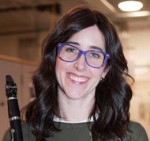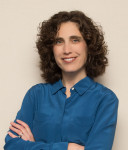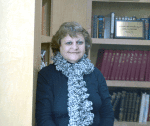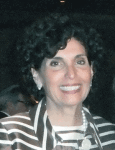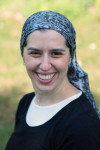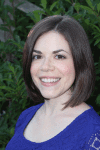Area Orthodox and Modern Orthodox women are pushing boundaries and making their voices heard both in the synagogue and in feminist circles
 By Amanda Koehn
By Amanda Koehn
In December 2016, Rivki Silver, a 36-year-old Cleveland Heights woman, wrote an opinion piece for Kveller, a Jewish parenting website, that she says made her feel “nauseous and terrified.” The piece was about how as an Orthodox mother of four children, Silver opposed a now-vetoed Ohio bill that would ban abortions past when a fetal heartbeat is heard (or at about six weeks of pregnancy). Silver wrote that women should make such decisions themselves and with their religious leaders, and not the government.
“I felt like coming from an Orthodox perspective and coming from Ohio, it had the potential to be a very powerful piece,” she says, adding however that she was afraid of it being ill received by her community. “People don’t expect someone who’s Orthodox to be writing an article on that topic.”
Silver, a member of Congregation Beis Doniel in Cleveland Heights, is no novice to writing publicly about issues important to observant Jewish women. She’s also written about using birth control the first time (which she says most of her Orthodox friends have used at some point) or why it’s important to find balance between familial privacy and sharing for communal support. Despite fears, Silver says she ended up receiving “a tremendous outpouring of support” for the abortion piece.
“Some people were like, ‘Oh my gosh, I can’t believe that you did that,’ but the vast majority were like, ‘I think it’s important that you said it,’” Silver says.
Silver, who converted to Orthodox Judaism from a Christian background when she was 25, is one of many women in the Cleveland area who is making her voice heard in a way that speaks to both religious and secular feminists. While Silver has chosen to speak out on community and secular issues, area Orthodox women are also changing women’s roles in the religious world in ways that defy stereotypes.
- “People should know that you can be in the box and also out of the box. You can be traditional, and you can be a feminist.” Rivki Silver
- “The biggest strides in the Orthodox world in general are in women’s learning.” Alanna Cooper
- “There were some people t hat, you know, maybe had issue not with me personally but just the concept (of a female synagogue president).” Muriel Weber
‘Feminist’ issues
While some say the term “feminist” can be divisive and politicized, others believe its baseline definition – that men and women should have equal opportunities – is too sprawling and needs to be reserved only for those who advocate for policies that actively deconstruct a patriarchal society. Thus, for many Orthodox women, the word is complicated – possibly even more so.
Silver says that while she describes herself as a feminist in some scenarios, it’s a “loaded” word.
“I feel like some people think it threatens the value of their role if they are a more traditional type,” she says.
Silver says she is traditional in the sense that she is largely a stay-at-home mom and appreciates traditional values. However, as a clarinetist and writer, she also likes to refute the stereotype that “traditional” is at odds with those artistic and feminist identities.
“People should know that you can be in the box and also out of the box,” she says. “You can be traditional, and you can be a feminist.”
For Orthodox women like Silver, such complexities become even more pronounced because of gender-based issues specific to religious observance. Divorce (which men traditionally need to approve), women in leadership and ritual inclusion are three issues Orthodox women consider in regard to what halachah, or Jewish law, allows, according to the Jewish Orthodox Feminist Alliance, a national group for women’s progress in the Orthodox community.
“The biggest strides in the Orthodox world in general are in women’s learning,” says Alanna Cooper, a cultural anthropologist who is on the all-woman board of officers at the Modern Orthodox Oheb Zedek-Cedar Sinai synagogue in Lyndhurst.
According to JOFA, Cedar Sinai was first in the U.S. to elect an all-woman board in June 2016. It was a quick rise, too: Muriel Weber, now 59, had just become the synagogue’s first female president three years earlier. She says then, the synagogue’s leadership was still somewhat of an “old boys club.”
“There were some people that, you know, maybe had issue not with me personally but just the concept,” says Weber, who is now the synagogue’s treasurer.
Arlene Smith, 62, who succeeded Weber as president in June 2016, says after Weber improved the financial health of the synagogue and grew the “shul family,” there were fewer roadblocks for women’s leadership.
“I think we’ve proven ourselves along the way,” Smith says.
However, other areas of women’s inclusion are more controversial within Orthodoxy. One of those areas, ritual inclusion, is another area where Cleveland-area Jews are just beginning to push boundaries.
Partnership Minyan
One March Shabbat morning, about 30 people, mostly Modern Orthodox, gathered at a private residence in Beachwood for a service. Like an Orthodox synagogue, there was a barrier between men and women, which in this case was a 5-foot-tall white sheet hanging on what looked like clothes racks.
Unlike an Orthodox synagogue, women led all the parts of the services halachah allows, based on JOFA guidelines for partnership minyans, or services that maximize women’s participation. This Cleveland Partnership Minyan, which began last Sukkot and now occurs monthly, has many counterparts around the world, but is a first for Northeast Ohio.
During the service, men led parts, like kaddish, that require a minyan, or 10 men, while a female gabbai, or the ritual leader, did much of the rest. Also not seen in Orthodox synagogues, women accepted aliyahs, or read from a Torah, which was kept in a large wardrobe behind a makeshift bimah, created from folding tables and a white sheet.
The men’s and women’s sides were also equidistant from the bimah, which to Ali Stern, the 33-year-old Modern Orthodox founder of the minyan, is an important detail.
“If you go to an Orthodox minyan and there is no access to the bimah (for women), to me it reflects that the value of the shul is that women are not having access because we don’t need you to have access,” she says.
Stern, a University Heights resident who attended a Reform synagogue growing up in Boulder, Colo., transitioned to Orthodox Judaism as a college student at Brandeis University in Waltham, Mass. Stern says while she was struck by her spiritual connection to Orthodoxy and loved the way observing Shabbat was a kind of resetting from our technology-centered world, she was frustrated by women’s absence from rituals.
“To say I’m OK with never having access to the most beautiful part of the service, I’m never going to see those letters (of the Torah) again – how am I going to be able to deal with that in my heart for the rest of my life?” she says, noting that she has been an advocate for women’s issues for as long as she can remember. “How am I going to be able to do that not just as a Jew, but as a woman?’”
After attending partnership minyans in Cambridge, Mass., and Israel, when Stern learned about three years ago that she was moving to Northeast Ohio for her husband Noam’s medical residency, she was surprised there wasn’t one there.
“When we got here, I felt there must be other women – and men – who feel the way I do,” says Stern, who also attends Green Road Synagogue in Beachwood and Cedar Sinai.
After adjusting to the Cleveland Jewish community for a few years, this past political season was one of the factors that gave Stern the push to create a partnership minyan herself, explaining that people were looking to connect spiritually in the face of partisan negativity.
“I think that people weren’t willing to settle anymore for models that weren’t what they want,” she says.
Stern also found a fellow Cambridge minyan alum and Cleveland-area transplant in Cooper.
Cooper, 49, started the Cambridge partnership minyan in 2003, after seeing early models in Jerusalem and New York City. She notes that partnership minyans came about – not by accident – at about the same time two well-known articles came out supporting such arrangements. “Qeri’at ha-Torah by Women: A Halakhic Analysis,” by Rabbi Mendel Shapiro and “Congregational Dignity and Human Dignity: Women and Public Torah Reading,” by Rabbi Daniel Sperber both argued, somewhat controversially, that women can read from the Torah in some circumstances.
“The articles by these (rabbis), who have halachic training, kind of gave permission to people to go out and do it,” Cooper says.
- “Unfortunately, women are really fighting for a role in the synagogues (and) they are fighting for a role in Jewish communal life.” Arlene Smith
- “We don’t really talk about rights (in Jewish observance), we talk about responsibilities and obligations.” Sarah Rudolph
- “To say I’m OK with never having access to the most beautiful part of the service, I’m never going to see those letters (of the Torah) again – how am I going to be able to deal with that in my heart for the rest of my life?” Ali Stern
Religious difference
The partnership minyan model is not universally accepted within Orthodox circles, with some believing it violates halachah or is simply not in line with long-held tradition. Stern says some women will attend without their husband because he doesn’t feel comfortable with it.
“Obviously, we would love if families could come together, but it’s also great that if there is a member of a couple who is not finding spiritual fulfillment, that we are providing an avenue,” she says. “A lot of people think that what we are doing, they would say it’s not Orthodox. And that’s OK with me. I don’t need a stamp of approval from every single person in the community.”
Sarah Rudolph, a freelance Torah teacher and friend of Stern’s, says if a woman feels personally drawn to traditionally male roles, like reading the Torah in shul, she should study halachic sources and determine for herself whether she should do so.
Unlike Stern, Rudolph, of University Heights and a mother of four, says she has never had the urge to read from the Torah in shul, however she is used to putting herself in scholarly places that have been male-dominated. She frequents Jewish bookstores in search of Talmudic texts and says it sometimes surprises the bookstore owners that a woman is seeking such material.
“I’ve been met with surprise but never disrespect,” says Rudolph, who is a member of Green Road Synagogue and Young Israel of Greater Cleveland in Beachwood.
Rudolph’s views on feminism and its role in Orthodox life are also complex.
She clarifies that within Jewish observance, there is a distinction that “we don’t really talk about rights, we talk about responsibilities and obligations,” and feminism itself is less helpful for her as an independent value system. Thus, while there are things people have a “right” to do, their responsibilities to halachah are a different matter.
“I appreciate that feminism was an important movement for society at large,” she adds.
Weber also says although she identified with some feminist ideology when she worked in banking in the 1980s (she’s now retired) and women had to “literally elbow their way in,” she now finds it less essential.
“I’m hoping that we are kind of beyond that because to me it’s a label, plus it’s become, in our society, politically charged,” says Weber, adding, however, that there are still some glass ceilings to be broken. “I think you can do those things, in many instances, with your accomplishments and with your skills.”
Smith, Weber’s colleague at Cedar Sinai, added while she also has never identified with feminism, her daughter, Rabba Ramie Smith, who is one of only about 14 Orthodox rabbas in the U.S., has made her realize the pushback Orthodox women still face. In February, the Orthodox Union – the movement’s umbrella organization – barred women from serving as synagogue clergy.
“Unfortunately, women are really fighting for a role in the synagogues (and) they are fighting for a role in Jewish communal life,” Smith says.
Halachah and women
Rudolph also pointed out the idea that feminism always requires pushing back on halachic traditions, could create the misconception that Orthodoxy is inherently repressive – something none of the women suggest and in some ways, they say is the opposite.
Stern says that while some practices of Orthodoxy were difficult for her – for example, the idea of covering her hair (she doesn’t, except at services) and not having access to the Torah – one aspect she came around on was men and women praying separately. She says the separation lets her build relationships with women whom she wouldn’t otherwise approach.
“If my friend was sitting with her husband and her kids, I would respect that space, but because that’s inherently not part of the service, we are all just a community, we aren’t divided up by who has a spouse (or) who has kids. We are all just people,” says Stern, whose 1-year-old son, Ori, crawled back-and-forth at the minyan from his father on the men’s side to Stern on the women’s.
Silver also says that as someone who’s had “feet in both worlds,” she is glad her daughter, Naomi, 4, is growing up in an environment with strong female role models, both as career leaders and “vibrant Torah teachers,” and where women are closely connected to one another.
“There’s a lot of under-appreciated female power that kind of gets amplified when you get so many women together,” Silver says. js
Learn more
For additional information about the Cleveland Partnership Minyan, visit facebook.com/CLEPartnershipMinyan.

